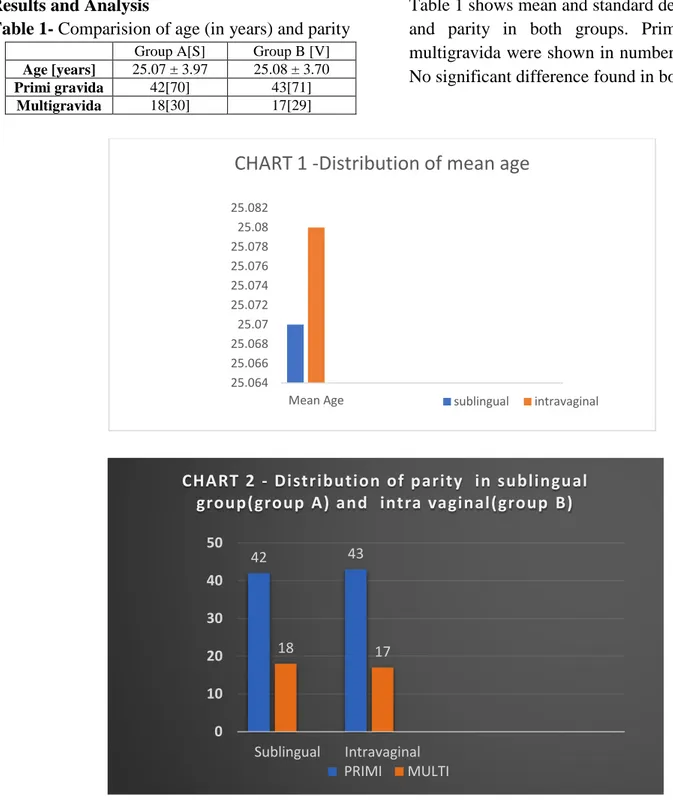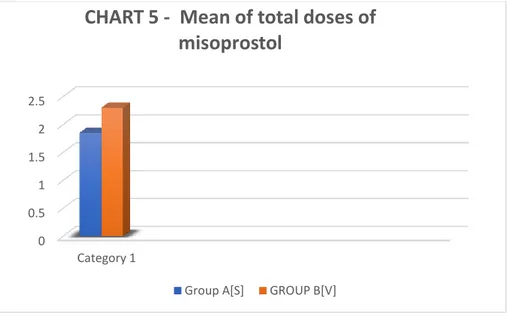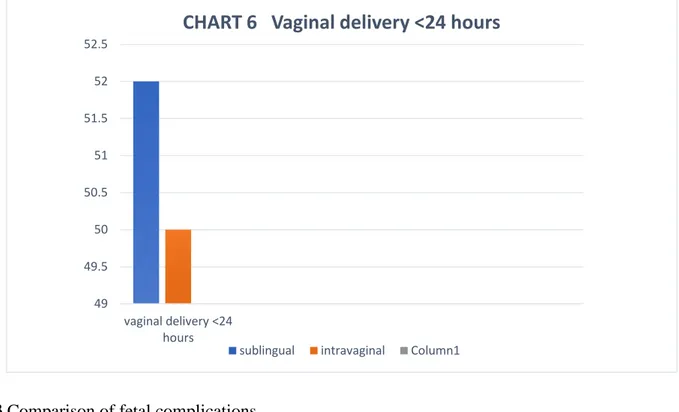Dr Raga Malika Devi Gontla et al JMSCR Volume 08 Issue 02 February 2020 Page 124
Obstetric and Neonatal Outcome of Induction of Labour at term with
Sublingual Misoprostol as Compared to Intravaginal Misoprostol
Authors
Dr Raga Malika Devi Gontla
1, Dr Shailaja Prasad
2, Dr Anitha
3, Dr Swetha
4 1,4Post Graduate, Department of Obstetrics and Gynecology
2
Professor of Obstetrics and Gynecology
3
Assistant Professor of Obstetrics and Gynecology
Abstract
Background: Misoprostol, a synthetic prostaglandin E1 analog, has been given both orally and vaginally for induction of labor at term. Due to the difference in pharmacokinetics of sublingual as compared to vaginally administered misoprostol, hence this study.
Aim: To study Obstetric and Neonatal outcome of induction of labour with sublingual misoprostolas compared to intravaginal misoprostol.
Method: 120 women with singleton pregnancy with no Cephalo-pelvic disproportion were randomized
to receive Tab. Misoprostol 25mcg at 4 hour interval by vaginal route (60 patients) and sublingual route (60 patients).
Results: With sublingual route of administration the number of doses of misoprostol used was significantly lower [p<0.05], reduced induction delivery interval [p<0.05], reduced pelvic examinations [p<0.05] when compared to vaginal route of administration. No difference in maternal and foetal complications.
Introduction
Induction is defined as stimulation of contractions before the spontaneous onset of labor, with or without ruptured membranes. When the cervix is closed and uneffaced, labor induction commences with cervical ripening, a process that generally employs prostaglandins to soften and open the cervix1.Some centuries ago, fetal death was the only indication for labor induction. Now, in modern obstetrics, induction of labor at term in a live foetus with successful outcome is a challenge to obstetrician. Now-a-days the rate of labor induction varies in different centers. Despite a large body of literature, the optimal mode of induction for this purpose has yet to be established.
Methods of Induction of Labor2
a) Pharmacological- oxytocin, prostaglandins like PGE1 (misoprostol- tablet) and PGE2 (dinoprostone-gel, tablet and controlled release pessary), progesterone receptor antagonist-mifepristone.
b) Non-pharmacological- mechanical and surgical
Mechanical- mechanical dilators, foleys catheter (single balloon), trans cervical double balloon catheter, osmotic dilators, laminaria tents (natural) or dilapan (synthetic), extra amniotic saline infusion. Surgical – sweeping of membranes and
amniotomy (artificial rupture of membranes).
http://jmscr.igmpublication.org/home/ ISSN (e)-2347-176x ISSN (p) 2455-0450
Dr Raga Malika Devi Gontla et al JMSCR Volume 08 Issue 02 February 2020 Page 125 There is no preferred method for induction and it
depends on institute protocol.
There is increased risk of failed induction and caesarean section in presence of unfavorable cervix3 and hence cervical ripening is needed .
Aim of the Study
To study obstetric and neonatal outcome of induction of labor at term with sublingual misoprostolas compared to intravaginal misoprostol.
Objective of the Study
To determine efficacy and safety of sublingual administration of misoprostol compared with vaginal misoprostol at or after term pregnancy in a women with a live foetus.
Materials and Methods
This study was conducted in Great Eastern Medical School and Hospital, Ragolu, Srikakulam, Andhra Pradesh in the department of obstetrics and Gynaecology during the period of December 2018 to June 2019 (6 months).
120 antenatal women admitted in the ward were included in this study.
Inclusion Criteria
1. Singleton pregnancy 2. Live foetus
3. Term gestation - 37 completed weeks or more with a medical or obstetric indication for induction including gestational age >/ 41 weeks (post dated pregnancy), prelabour rupture of membranes (PROM) ,gestational hypertension, mild pre eclampsia ,gestational diabetes mellitus (GDM) . 4. Primigravida and multiparous women 5. Cephalic presentation
6. An unfavourable cervix (bishop score <5 ) 7. Reassuring foetal heart tracing.
Exclusion Criteria
1. Multiple gestation
2. Malpresentation ( other than cephalic) 3. Previous uterine surgery (hysterotomy,
myomectomy, caesarean section)
4. Contraindications for the use of prostaglandins like asthma
5. Grand multipara ( >5) 6. Need for immediate delivery 7. Chorioamnionitis
8. Active Vaginal bleeding
9. Ultrasonically confirmed severe oligohydramnios, placenta praevia and macrosomia.
10.Abnormal doppler velocimetry
Methodology
Group A: Sublingual misoprostol [S]
60 patients for labour induction were randomly allocated for 25 microgram sublingual misoprostol administration every 4th hourly for maximum of 6 doses.
Group B: vaginal misoprostol [V]
60 patients for labour induction were randomly allocated for 25 microgram vaginal misoprostol administration every 4th hourly for maximum of 6 doses.
Further induction is withheld if women had regular contractions (3-4 contractions, lasting for more than 40 seconds in 10 minute duration,goes into active labor (4 cms) or cervix is favourable for amniotomy (bishop score >/8). Oxytocin was adminsterd by diluting inringer lactate solution and started as IV drip ,not earlier than four hours of last dose of misoprostol.
Continuous fetal cardiotocography was used throughout the study.
Dr Raga Malika Devi Gontla et al JMSCR Volume 08 Issue 02 February 2020 Page 126
Results and Analysis
Table 1- Comparision of age (in years) and parity Group A[S] Group B [V]
Age [years] 25.07 ± 3.97 25.08 ± 3.70
Primi gravida 42[70] 43[71]
Multigravida 18[30] 17[29]
Table 1 shows mean and standard deviation of age and parity in both groups. Primigravida and multigravida were shown in number [percentage]. No significant difference found in both groups.
Table 2: Comparison of bishop score
Group A[S] Group B [V] P value Bishop score 4.03±0.81 4.05±0.59 1.00 Table 2 shows mean and standard deviation of
Bishop score in both groups. no There was no
significant difference among the groups.
25.064 25.066 25.068 25.07 25.072 25.074 25.076 25.078 25.08 25.082
Mean Age
CHART 1 -Distribution of mean age
sublingual intravaginal
42 43
18 17
0 10 20 30 40 50
Sublingual Intravaginal
CHART 2 - Distribution of parity in sublingual group(group A) and intra vaginal(group B)
Dr Raga Malika Devi Gontla et al JMSCR Volume 08 Issue 02 February 2020 Page 127
Table 3: Comparison of indication for induction
Group A[S] Group B [V] Post term [>41 weeks] 28[46.7] 25[41.7]
Prelabour rupture of membrame 17[28.3] 18[30]
Mild preeclampsia 11[18.3] 14[23.3]
Gestational diabetes mellitus 4[6.7] 3[5]
Table 5: Comparison of total doses of misoprostol
Group A[S] Group B [V] P value Total doses of misoprostol 1.85±1.02 2.3±1.2 <0.05 Table 5 shows mean and standard deviation of
total doses of misoprostol in both groups.
Misoprostol used was significantly lower in sublingual route than vaginal route [p<0.05].
Table: 6 Comparison of number of vaginal examination
Group A[SLM] Group B [VM] P value Number of pelvic examination 5.75±2.05 8.22±2.04 P<0.05 Table 7 shows mean and standard deviation of
number of pelvic examination in both groups. Pelvic examination was significantly lower in
sublingual route misoprostol than vaginal route of administration [p<0.05].
3.9 3.95 4 4.05 4.1 4.15 4.2 4.25 4.3 4.35
Bishop Score 4.03
M E A N B I S H O P S C O R E
Group A{S}Group B{V} Series 2 Column1
0 0.5 1 1.5 2 2.5
Category 1
CHART 5 - Mean of total doses of
misoprostol
Dr Raga Malika Devi Gontla et al JMSCR Volume 08 Issue 02 February 2020 Page 128
Table 8: Comparison of induction delivery interval [minutes]
Group A[SLM] Group B [VM] P value Induction delivery
interval (min) 650.98±250.83 779.7±269.97 P<0.05
Induction vaginal
delivery interval (min) 597.42±186.47 720±195.47 P<0.005 Table 8 shows mean and standard deviation of
induction delivery interval including caesarean section [minutes] and induction vaginal delivery interval [minutes] in both groups. Induction
delivery interval including caesarean section and induction vaginal delivery interval was significantly lower in sublingual route misoprostol than vaginal route of administration [p<0.05]
Table 9: Comparison of mode of delivery
Group A[SLM] Group B [VM] RR [CI 95%]
Spontaneous vaginal delivery 49[81.7] 45[75] 1.09 [ 0.90 –1.32] Instrumental vaginal delivery 3[5] 5[8.3] 0.6 [ 0.15 – 2.40] Caesarean section 8[13.3] 10[16.7] 0.8 [ 0.34 -1.89] Table 9 shows number [percentage] of mode of
delivery in both groups. There was no significant
difference among the groups.
0 1 2 3 4 5 6 7 8 9
Pelvic Examination
CHART 7 Number of Pelvic Examination
Group A[S] Group B [V]
0 200 400 600 800
Induction delivery interval(min)
induction vaginal delivery interval(min)
Dr Raga Malika Devi Gontla et al JMSCR Volume 08 Issue 02 February 2020 Page 129
Chart 9 Mode of Delivery
Table 10 Comparison of indication for caesarean section
Group A[SLM] Group B [VM] RR [CI 95%]
Fetal distress 2[25] 3[30] 0.83 [ 0.18 – 3.84]
Non progress of labour / arrest of labour
4[50] 4[40] 1.25[0.45 – 3.49]
Failed induction 2[25] 3[30] 0.83 [ 0.18 – 3.84]
Table 10 shows number [percentage] of indication for caesarean section in both groups. There was no significant difference in fetal distress, non
progress of labour / arrest of labour and failed induction among the groups.
Chart 10 Comparision for indication for induction
Chart 11 Comparison of maternal uterine complications
Group A[SLM] Group B [VM] RR [CI 95%]
Uterine Hyperstimulation 3[5] 2[3.3] 1.5 [0.26 – 8.66] Table 12 shows number [percentage] of maternal
uterine complication in both groups. There was no
significant difference among the groups.
82% 5%
13.30% 0
GROUP A [S]
Spntaneous vaginal delivery
Instrumental vaginal delivery
Caesarean
Section 75%
8%
17% 0
GROUP B [V]
Spontaneous vaginal Delivery
Instrumenta vaginal delivery
25%
50% 25% 0
GROUP A[S]
Foetal Distress
Non progression or arrest of labour
Failed induction
30
40 30
0
Foetal Distress
Non progression of labour/Arrest of Labour
Dr Raga Malika Devi Gontla et al JMSCR Volume 08 Issue 02 February 2020 Page 130
Chart 11
Table 4 shows number [percentage] of indication for induction in both groups. There was no
significant difference among the group
Chart 4 shows percentage of indication of induction.
Table 12 Comparison of birth weight of baby [kilograms]
Group A[SLM] Group B [VM] P value
Baby birth weight [kgs] 2.89±0.23 2.90±0.19 0.83 Table 12 shows mean and standard deviation of
baby birth weight [kilograms] in both groups.
There was no significant difference among the groups.
GroupA[S] Group{V}
Column1
0 1 2 3
Hyperstimulation
Frequency of Hyper Stimulation
GroupA[S] Group{V}
post term, 28
pre labour rupture of membran
es, 17 mild pre-eclampsia
, 11
GDM, 4
GROUP A [S]
Post term, 25
pre labor rupture
of membra
nes, 18
mild preecla
mpsia, 14
GDM, 3
GROUP B[V]
2.884 2.886 2.888 2.89 2.892 2.894 2.896 2.898 2.9 2.902
Birth Weight(kg)
Comparision of Birth Weights
Dr Raga Malika Devi Gontla et al JMSCR Volume 08 Issue 02 February 2020 Page 131
Group A[SLM]
Group B
[VM]
RR [CI 95%]
Meconium
passage
Apgar score <7
at 5minutes
3[5]
3[5]
1 [0.21 – 4.76]
2[3.3]
2[3.3]
1 [0.15 – 6.87]
NICU admission
1[1.6]
2[3.3]
0.5 [ 0.05 –
5.37]
Table 7: Comparison of number of pelvic delivery in< 24 hours of inductionGroup A[S] Group B [V] RR [CI 95%] Vaginal delivery
< 24 hours
52[86.7] 50[83.3] 1.04 [0.89 -1.20] Table 6 shows number [percentage] of vaginal
delivery in <24 hours in both groups. There was
no significant difference among the groups.
Table 13 Comparison of fetal complications
Table 13 shows number [percentage] of fetal complication in both groups. There was no
significant difference among the groups. 49
49.5 50 50.5 51 51.5 52 52.5
vaginal delivery <24 hours
CHART 6 Vaginal delivery <24 hours
Dr Raga Malika Devi Gontla et al JMSCR Volume 08 Issue 02 February 2020 Page 132
Chart 13 Comparison of foetal complications
Discussion
In our study we had included 120 antenatal women by randomization technique.
There was no difference in age, parity, gestational age, bishop score and indication of induction among the both groups in our study. The results had showed that 25μg of sublingual misoprostol administration resulted in significantly shorter induction to delivery interval [p <0.005], with a lower number of misoprostol doses required [p<0.01] and lesser number of pelvic examination [p<0.05] required as compared with those administered 25 μg of vaginal misoprostol.
In present study no statical significant difference was found in age group, parity, induction to delivery interval, which is similar in Jahroni bahia namavar et al5 study (2009-2011), Ayathi et al6 study (2007-2008).
In present study, there is no statistical significant difference in bishop score in both groups.Similar results were observed in jahroni study but In Ayathi etal study , bishop score was found higher in sublingual when compared to vaginal group. In Tang et al.7 study, the sublingual route has been shown to produce significantly higher serum peak concentration of misoprostol than either oral or vaginal administration.
A recently published study evaluated the effects of misoprostol on uterine contractility following different routes of administration10. The sublingual application of misoprostol had rapid
effect on uterine contractility as oral administration and the bioavailability was similar to vaginal administration. We had administered sublingual dosage every 4th hourly. These findings may explain the significant reduction in induction delivery interval with sublingual misoprostol. Our study had showed a significant reduction in number of pelvic examination before delivery. Patient would be comfortable when number of pelvic examination was reduced. We had not taken satisfaction parameter in our study as it was beyond our scope.
Nasser et al11 had studied on patient satisfaction criteria and concluded that sublingual misoprostol was convient and satisfactory route. This route of administration may reduce the chance of infection particularly in PROM cases because of less number of vaginal examinations required. On considering these facts and our observation on significant decrease in number of pelvic examination sublingual route may be a satisfactory route of administering misoprostol.
Conclusion
Sublingual dosing for labour induction is attractive because of ease of administration, less frequent need for vaginal examination, possibility of its use in case of vaginal bleeding or ruptured membranes and better patient acceptability. We believe further studies on safety with large number of women need to be conducted before we
3
2
1 3
2 2
0 0.5 1 1.5 2 2.5 3 3.5
meconium passage APGAR <7 at minutes NICU admission
GROUP A[S]
Dr Raga Malika Devi Gontla et al JMSCR Volume 08 Issue 02 February 2020 Page 133 advocate sublingual misoprostol as routine labour
induction agent.
References
1. Gary, F. Williams Obstetrics. (25 ed.). United States Of America: ; c2014. 2. Dutta, D.C. Text book of obstetrics
including contraception and perinatology. (7 th ed.). United States Of America: Hiralal konar; 2013.
3. Hofmeyr GJ. Induction of labour with an unfavourable cervix. Best Pract Res Clin Obstet Gynaecol 2003; 17:777–94.
4. Jahromi BN, Poorgholam F, Yousefi G, Salarian L. Sublingual versus Vaginal Misoprostol for the Induction of Labor at Term: A Randomized, Triple-Blind, Placebo-Controlled Clinical Trial. Iran J Med Sci. 2016;41(2):79–85.
5. Ayati S, Vahidroodsari F, Farshidi F, Shahabian M, Afzal Aghaee M. Vaginal versus sublingual misoprostol for labor induction at term and post term: a randomized prospective study. Iran J Pharm Res. 2014;13(1):299–304.
6. Tang OS, Schweer H, Seyberth HW, Lee SW, Ho PC. Pharmacokinetics of different routes of administration of misoprostol. Human Reproduction 2002; 17:332–6. 7. Aronsson, M. Bygdeman and K.
Gemzell-Danielsson. Human Reproduction 2004; Vol.19 No.1:81-84.


![Table 8 shows mean and standard deviation of induction delivery interval including caesarean section [minutes] and induction vaginal delivery interval [minutes] in both groups](https://thumb-us.123doks.com/thumbv2/123dok_us/7937443.2110016/5.892.213.754.631.1028/standard-deviation-induction-delivery-including-caesarean-induction-delivery.webp)
![Table 12 shows number [percentage] of maternal uterine complication in both groups](https://thumb-us.123doks.com/thumbv2/123dok_us/7937443.2110016/6.892.83.805.558.862/table-shows-number-percentage-maternal-uterine-complication-groups.webp)
![Table 4 shows number [percentage] of indication for induction in both groups](https://thumb-us.123doks.com/thumbv2/123dok_us/7937443.2110016/7.892.147.691.98.386/table-shows-number-percentage-indication-induction-groups.webp)
